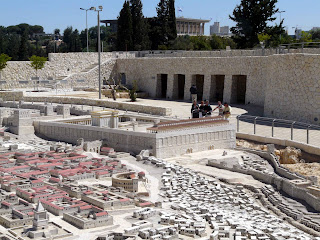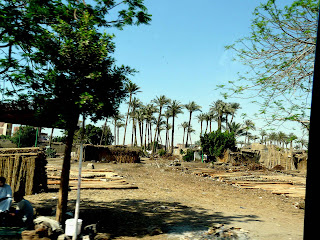 A Bedouin village in the West Bank, along the road to Masada
A Bedouin village in the West Bank, along the road to Masada Another Bedouin village in the West Bank, on the road to Masada
Another Bedouin village in the West Bank, on the road to Masada Rehearsal for Remembrance Day ceremonies on Mt. Herzl
Rehearsal for Remembrance Day ceremonies on Mt. Herzl The scale model of Jerusalem showing the Western Wall of the Temple Mount, with the Second Temple sitting atop the Temple Mount (Please double left-click on the image; at the intersection of the two wall sections, the Western Wall is the left-hand section, and the Southern Wall is the right-hand section.)
The scale model of Jerusalem showing the Western Wall of the Temple Mount, with the Second Temple sitting atop the Temple Mount (Please double left-click on the image; at the intersection of the two wall sections, the Western Wall is the left-hand section, and the Southern Wall is the right-hand section.) Joyce at the Western Wall with appropriate head dress
Joyce at the Western Wall with appropriate head dress A rest stop in the West Bank, on the way to Masada (it was here that an Arab offered 25 camels for Joyce -- insulting because 100 pigs and many cassowary feathers and pigs' teeth had been offered in Papua New Guinea)
A rest stop in the West Bank, on the way to Masada (it was here that an Arab offered 25 camels for Joyce -- insulting because 100 pigs and many cassowary feathers and pigs' teeth had been offered in Papua New Guinea) Israeli soldiers at the West Bank rest stop
Israeli soldiers at the West Bank rest stop Dome of the Rock seen from the Mount of Olives
Dome of the Rock seen from the Mount of Olives Russian Orthodox Church on the Mount of Olives
Russian Orthodox Church on the Mount of Olives Garden of Gethsemane and the Church of All Nations
Garden of Gethsemane and the Church of All Nations King David Hotel seen from the Mount of Olives (our room faced the Old City)
King David Hotel seen from the Mount of Olives (our room faced the Old City) Joyce and Jules at the Joffa Gate to the Old City of Jerusalem
Joyce and Jules at the Joffa Gate to the Old City of JerusalemWe are in Taormina, Sicily, and have just returned from climbing Mt. Etna (not from the bottom; please remember our ages). Truly a spectacular sight, with plumes of steam and ash venting from crevices in the mountain. Pix of Mt. Etna will be on our Sicily post. (And, no, we have not forgotten our overdue posts on Hong Kong and Bangkok.)
We traveled in Israel for a week, and contrary to the impression conveyed by the MSM, we did not once hear or see anything that even hinted at danger, and we never felt that our safety was at issue. This notwithstanding the fact that we spent a good portion of our time in the Arab quarters of Jerusalem, Safed, Akka and Joffa, and in traveling in the West Bank to and from Masada and the Dead Sea. A little known fact: there are approximately 1 million Arab Israelis living in Israel, and about 6 million Jewish Israelis.
Jerusalem is rightly considered one of the most intriguing and important cities on this planet. It is obviously most appreciated with some knowledge of the Old and New Testaments, the history of Judea in the first centuries of the Common Era, the rise of Islam starting in the 7th century C.E., the crusades, Zionism, the founding of the State of Israel, the four wars between Israel and its Arab neighbors, etc.
Our hotel in Jerusalem was the King David, and our room was in the part that was bombed by the Irgun in 1946. We had a magnificent view of the old city of Jerusalem from our hotel room. However, the hotel is in need of a renovation, and although nominally a 5-star, it is living off past glory.
We were blessed with a learned tour guide (Ph.D. in history), and our tour started at the Mount of Olives, from which the Dome of the Rock and Al Aqsa mosque are plainly visible, and at the foot of which is the Garden of Gethsemane marked by the Church of All Nations.
After a tour of the excavations under Jerusalem, which have revealed a Roman road and the extent of the Western wall of the Temple Mount, we followed the Via Dolorosa and eventually visited the Church of the Holy Sepulchre located at Golgotha. There are no less than six sects that share the site of the Holy Sepulchre, including desperately poor Ethiopians and fabulously wealthy Eastern Orthodox. Perhaps one of the most vivid spectacles was a Polish group that literally knelt at the site of the Resurrection and kissed the stone there.
The trip to Masada through the West Bank was most notable for its views of the countryside, including date palm and banana plantations and Bedouin villages (not much more than tar paper shacks). We had an interesting enclounter at a rest stop in the West Bank, where a camel owner spotted Joyce's blond hair and offered 25 camels on the spot for her. The offer was rejected out of hand -- in Papua New Guinea the bride price for Joyce reached 100 pigs plus a large but unspecified number of cassowary feathers and pigs' teeth. The presence of young Israeli soldiers at the rest stop was both reassuring and unnerving, given their obvious youth and evidently well-used automatic weapons.
Since our visit coincided with Israel's 60th anniversary celebration, which includes both a Rembrance Day for the fallen Israeli soldiers followed by Independence Day, we witnessed a rehearsal of the Remembrance Day event on Mt. Herzl (see photos). No visit to Jerusalem would be complete without spending some time at Yad Vashem. I had visited Yad Vashem in 1989 with Eric and Mark, and since then it has been redesigned by Moishe Safdie, and as moving as it was in 1989, it is now an architectural marvel that does not intrude on the visual experience of the events depicted in the exhibitions.
One of the more interesting sites was a reconstruction of Jerusalem as it was described by Josephus Flavius, in a large outdoor model that reveals the position and geographic detail of the Temple Mount. Briefly, the Temple Mount was constructed by Herod to level out the hills and valleys around the peak of Mt. Moriah (Abraham and Isaac), and the Second Temple was then constructed on top of the Temple Mount, on the site of the First Temple. After the destruction of the Second Temple in 70 C.E., all that was left was a portion of the western and southern walls of the Temple Mount, not the temple itself. (The western wall is also referred to as the Wailing Wall, but it is more accurate to refer to it as the Western Wall.) The Dome of the Rock is located on the Temple Mount, on the site of the First and Second Temples.








































